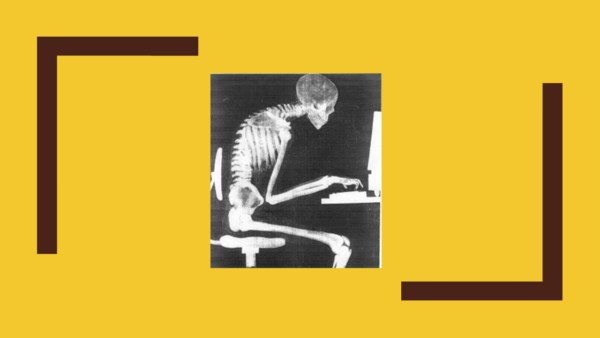Sitting is said to be the new smoking.
And I tend to agree.
The dangers of sitting are being increasingly studied and documented, so there’s science out there to prove what I’m about to say.
From studies, we know that:
- The average North American sits for 5 hours a day in front of a screen, including toddlers.
- 80% of jobs today are almost entirely sedentary.
- Many of us spend 90% of our leisure time sitting.
And the consequences of this time invested in sitting are becoming clear:
- It’s been shown that regardless of the amount of time you exercise, the amount of time you spend sitting puts you at greater risk of heart disease: 40% greater if you sit 6 or more hours a day.
- Between 1980 and 2000, although exercise rates among the population remained stable, the amount of time spend sitting increased 8% and obesity actually doubled.
- In studies which restrained the mobility of mice, the enzyme which removes fat from the blood stream was barely produced and fat accumulated in the blood – a simple recipe for heart disease, obesity, and diabetes.
- In another study which had healthy men remain immobile for just 24 hours, symptoms for insulin resistance developed.
Another common side-effect of sitting is something I see all too often in my practice: lower back pain.
Why does this happen?
Well, there a couple of possible anatomical reasons for this.
One is that our core muscles are weak from under-use. These are especially the deep abdominal muscles as well as the muscles of the lower back.
The core muscles are the body’s anchor. When they’re solid, the legs and arms can move freely from a stable center. When they’re weak, the back won’t be stable when moving the limbs, and that could causing pulling or muscular imbalances.
The next is shortened hamstring muscles and weak glutes.
When we sit, our hamstrings are in a shortened position and we’re just sitting on our glutes. So, when we sit for long periods of time, we’re essentially training our hamstrings to be short and tight, and our glutes to be weak and flabby.
But the thing is, the hamstrings are part of a kinetic chain of muscles along the back of the body. When the hamstrings are short and tight, they’ll pull of the muscles they’re linked to, including the muscles of the lower back, possibly leading to lower back pain.
And with weak, flabby glutes, it’s hard to stand tall and support the torso. Instead, the lower back might take some of the load, and that compensation of the back could lead to pain.
The thing is, just looking at our anatomy, our bodies weren’t designed to sit.
In fact the chair wasn’t even invented until the Egyptians came along about 5000 years ago. That means we spent 195,000 years before that with no chairs.
Also, we’ve got proof in our over 200 bones and joints, and over 600 muscles.
They’re not just there to look pretty. They’re there to allow your body to run, walk, bend, squat, twirl, jump, dance, and procreate.
However, when we don’t move these joints and muscles regularly, they stop doing the things they were meant to do.
But, to be fair, the fact we’re sitting so much isn’t totally our fault.
From a very young age we’re taught to sit.
“Sit down and be quiet!” may be something you heard frequently as a child, or maybe say to your children today.
But in making kids sit for long periods of time, we’re not only causing their muscles to atrophy, and their joints to stiffen, we’re also inhibiting their ability to learn and focus.
Exercise benefits the brain as much as the body.
When we move, blood flows, and blood is oxygen.
This oxygen is needed to repair and build muscle and bone, and to renew brain cells, among many other things.
So, although a lot can be learned by sitting and reading a book, a lot more can learned by keeping the brain cells healthy and regenerating.
So the antidote to sitting?
Easy. Movement.
How do we move more?
Just get up and move. The more often the better.
So if you have a sit-down job, get up every 15 to 20 minutes and move your body. Or if you’re a teacher, incorporate frequent movement breaks for your students.
Contrary to what you might think, it’s not a waste of time to do this. In fact, it will encourage more focus and better learning.
It will also help prevent bone loss, lower back pain, heart disease, asthma, obesity, diabetes, cancer, and the list can go on.
We’re living in modern times, with modern lifestyle-related diseases that weren’t even an issue until fifty years ago.
It’s time to get back to basics and get moving.
If you’re interested in another perspective, check out this entertaining Ted Talk by male model Roger Frampton called “Why Sitting Destroys You”: https://www.youtube.com/watch?v=jOJLx4Du3vU
Now, enough sitting. Get out there and enjoy this fall weekend!
Debbie


